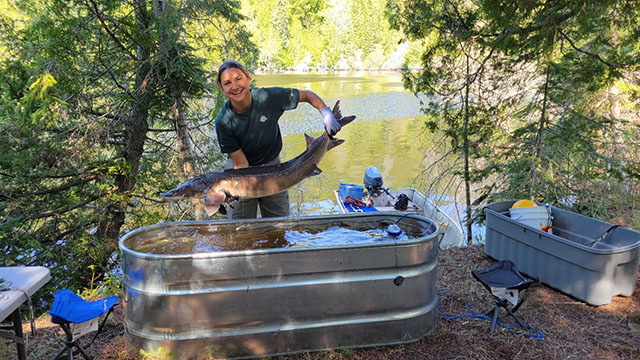Tracking the movement of Lake Sturgeon
Pukaskwa National Park

Lake Sturgeon is a bottom feeding, freshwater fish that has existed in the Great Lakes for about 10,000 years. With documented individuals up to 180 kg and measuring over 2 metres long, this species is one of the largest and longest freshwater fish species in Canada. Unfortunately, due to historic overfishing and associated habitat loss, Lake Sturgeon has been assessed as a “threatened” species in Ontario by the Committee on the Status of Endangered Wildlife in Canada (COSEWIC).
Protecting species at risk is important to maintaining and restoring biodiversity in Canada, which is essential to maintaining the existing ecosystem linkages and genetic diversity that help ecosystems support life. Aside from being an important part of the Lake Superior ecosystem, Lake Sturgeon also have a strong link to Indigenous history in the Great Lakes basin. The fish provided many uses- its meat, oil and roe were an important food source, its skin was used to store preserved or dried sturgeon, and its swim bladders were made into isinglass which was used as a glue.
The White River, a tributary of Lake Superior in Pukaskwa National Park, hosts one of the most abundant populations of Lake Sturgeon in Lake Superior. To understand the importance of the White River and park shorelines for this threatened species, Parks Canada staff captured and tagged 31 Lake Sturgeon. Acoustic transmitters were inserted into the belly of the fish to track their movements in the waters of Lake Superior. The transmitters are detected by receivers that are strategically placed along Pukaskwa’s coast and in embayments to monitor which areas of the coast the sturgeon have travelled to and to better understand how protection of the park’s lands and waters benefits these fish. As part of the Great Lakes Acoustic Telemetry Observation System (GLATOS), sturgeon that are tagged by other researchers in the lake can be detected on Pukaskwa receivers, while sturgeon from Pukaskwa may be detected on other receivers in the lake.
While data analysis is still ongoing, initial results have detected Lake Sturgeon at 14 of the 15 receivers in the park, heavily utilizing the White River and around the mouth of the river. Travel patterns have also shown that these fish tend to travel independently once they have left the river and that they utilize different portions of White River and the park shoreline throughout the year. Another interesting fact is that one sturgeon originally tagged in Michigan was detected frequently along the Pukaskwa coast during the first year of the study, showing the vast distances these fish can travel.
The future of the Lake Sturgeon monitoring program is to further document sturgeon usage of park waters with the addition of more receivers. Further analysis will also be done to calculate the park’s contribution to the protection and recovery of this species. Using the GLATOS network, there is also potential to understand the areas these fish go when not in the park.
- Date modified :